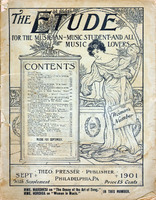Selected Content from the September 1901 Edition of The Etude
Of the many hundreds of women who officiate as church-organists throughout the length and breadth of this country, there are very few, indeed, who have ventured into the field as concert-organists. In fact, they might almost be counted on the fingers of one hand. This hesitancy on the part of women organists to enter the more exacting concert-field is due to a number of reasons. Read More
A large four-manual concert-organ is a masculine instrument, not because it has a pedal keyboard, but because its treatment must range from the most delicate and sympathetic to the boldest, grandest, and most majestic, requiring the widest angle lens in producing its tonal pictures and demanding the same combination of gentleness, firmness, boldness, and an instantaneous grasping of situations which is necessary in driving four spirited horses through the crowded city streets. Read More
It is sometimes said that men do not wish to take instruction from a woman. It has been my experience that the men have shown a spirit of chivalry and a desire to produce a perfect ensemble that was just the reverse of this. Read More
Some years ago it was unusual for a woman to study the organ. The difficult fingering, the heavy pedaling, the complicated stops were wisely deemed obstacles which ought to deter a girl from attempting it. Her physique was not equal to the strain. Read More
It may be true that women do not grasp the higher forms of theoretical study, but it remains yet to be proved that they cannot do so. The chances are that, when they become thoroughly awakened to the importance of serious study in this direction, they will set to work and master it just as they have mastered law, medicine, and other subjects for which they were formerly considered totally unfit. Read More
The fact of the matter is, that short limbs are better than long ones to manipulate the movable and melodic trestle-work that forms the floor of the organ-bench. Read More
It may come as a surprise to those who associate woman and the violin with the “innovations” of quite recent years, that two young girls should have achieved success as violinists so long ago as did the Milanolla sisters, for it is hardly more than thirty years ago that the girl, more especially the American girl, who appeared in the street with a violin under her arm was generally regarded as a new, if not ridiculous, species of feminity. Read More
O. H. ALBRECHT, THE WELL-KNOWN TEACHER and publisher of mandolin, banjo, and guitar music, has just issued a set of class studies, written by the clever composer, Thomas J. Armstrong, who is known throughout the country as the leading writer for small stringed instruments. Read More
Read More
Read More
There is no school where accompanying is made a special branch of instruction to fit one for the position of a professional accompanist. The latter is not a remunerative occupation, save in a few special instances. You had better stick to your piano-teaching and make accompanying an outside feature of your work. Read More
Bruckner’s “Ninth Symphony,” like Beethoven’s, is to be performed with a choral finale, for which purpose, according to the composer’s wish, expressed in his will, his “Te Deum in C” is to be used. Read More




